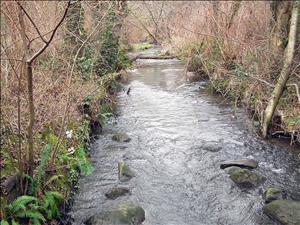In this reminiscence, originally published in the Jet City Maven, Green Lake resident Dorothea Nordstrand (1916-2011) recalls what it was like to live along Thornton Creek during the 1930s. Thornton Creek emerged near Green Lake and meandered through the present (2001) Northgate Mall to Lake Washington. In 2009 Dorothea Nordstrand was awarded AKCHO's (Association of King County Historical Organizations) Willard Jue Memorial Award for a Volunteer, for contributing these vivid reminiscences to various venues in our community, including HistoryLink.org's People's History library.
Thornton Creek Remembered
The controversy over what will happen to Thornton Creek, flooded me with memories from the 1930s. I would like to share those memories, for whatever they are worth.
Thornton Creek, as we knew it, rose somewhere near Meridian, meandered through some very black, boggy wetland, thence along or maybe under, what is now the South parking lot of Northgate Mall, and ran its sparkling way eastward until it emptied into Lake Washington.
It was a lovely, wooded area, the first such just a few blocks north of our Green Lake community. A pathway ran beside it. There was a canopy of trees, and mounds of tender undergrowth which ran down to the mossy banks. There were fish, and lots of wildlife. Many wild birds, the darting kingfishers, and an occasional Great Blue Heron to wade in the clear shallows. Squirrels, muskrats, raccoons, and mink lived there.
For about a month, in the spring of 1932, Charley, a friend of mine "ran" a line of traps along the stream. Very early every morning, before time to go to Roosevelt High School, we would meet near the creek, and he would check his traps. The line ran from about 10th Avenue (Roosevelt, now) to 15th Avenue.
It was understood that I would not see the animals, so he would climb down the bank to the creek, and if there was something in the trap, it would be hidden safely in his backpack, before he joined me. These were Depression years, and the extra income from the pelts he collected meant food on the table. Since our own family was also hard-strapped for income, I understood the need. My own reason for being there was simply for the joy of being outside in the early morning.
Later, after school, he would skin whatever he'd caught, clean off the flesh, and put the turned-inside-out pelts onto home-made, roughly triangular-shaped wooden stretch boards, where they would dry for about a week. Then they would be turned right-side-out, and carefully brushed, at which time they were ready to sell. The sale prices ranged from $0.75 to $1.00, although sometimes an especially fine mink would bring as much as $1.25.
Just north of the creek, if I remember right, there was a large truck garden, owned by an Italian family. I recall a large, comfortable farm house, although I'm am not sure of its exact location. Anyway, Thornton Creek was a lovely, green place. Many neighborhood folks fished there, and had picnics on its banks. It's pleasant to remember.

